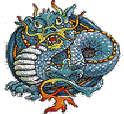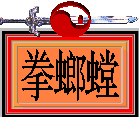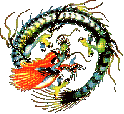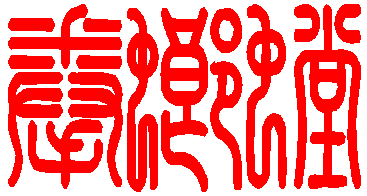   |
||
 |
 |
 |
   |
||
 |
 |
 |
| preface | legend | tutorial | game | links | main index |
Praying Mantis Kungfu
A praying mantis feeds himself with a cicada or a cricket, and is considered as one of the most cruel insects. It is called the "Fangschrecken" in German, with a meaning of "capturing by force". Another word in German that has exactly the same meaning like "praying mantis" is "Gottesanbeterin", originated also from the praying mantis' reverential-looking of holding the forelegs in front of his chest pretending the worship of God. The truth is merciless however, that the position of its forelegs is not for "praying" but "preying". The creation of the Praying Mantis Kungfu style by the great ancient Chinese martial artist Wang Lang is therefore not accidental. The praying mantis is really a brutal cannibal from which a real fighter has a lot to learn. There is a saying in China: 'While the praying mantis trys to catch a cicada in the front, a sparrow is planning an attack behind him', which tells the people not to concentrate only the visible benefit, but consider also the possible risk behind it before the making of a decision. This saying was already popular in the Warring States Period in China about two thousand years ago. The fact indicates, that praying mantis ability to fight had already been observed by the ancient Chinese even at that time.
Another legend might help understanding this fact better. In the said Warring Period, once the King of the State Yue was on his way to attack his enemy, the State Wu. Wu was much more powerful than Yue and the Yue soldiers in the march were not in a high fighting spirit, which had made their King worried. All of a sudden, he saw a praying mantis standing in the middle on the road threatenning with his two saws. In a lightning thought, the King ordered the war wagons to stop. His generals and the soldiers were fascinated and asked why. The King replied simply that a praying mantis was trying to push his wagon back on the wheel with its two arms. Every one laughed and suggested to roll over the daring praying mantis with the wagon. However, the King remained serious and ordered all the war wagons to pass on the side of the road, avoiding the praying mantis. He also ordered his generals What is more, he also ordered all the soldiers to stand in salute when passing the praying mantis for his respect to its courage. The soldiers had been moved deeply by their King's altitude and they fought a most victorious war later which had wrote one of the most adventurous chapter in Chinese war history. Hence the still popular saying in China: 'To stop a running wagon's wheel with the praying mantis' arms' meant 'the greatest courage' originally. Now it is having a negative meaning of 'doing something against the historical trend'. It is wrong! I still prefer its original positive meaning for 'a courage to fulfil a seemingly impossible task'. We always need courage and hope in our life, don't we? The anciet Chinese had observed the praying mantis for a long period of time till a martial artist among them named Wang Lang began to observe the same insect in a different way. Things look different with the eyes of a commoner and of a genius. The legend started when Wang Lang created the world famous Praying Mantis Kungfu style after observing this insect for good three years. It is surprising that now many began to know the praying mantis only when they first started the traing of the style. You type the two key words 'praying mantis' in any search engine in Internet, you won't only find a beautiful miss Praying Mantis enjoying her bridegroom's meat when you see her, but many impressive sites of the praying mantis kungfu, and mine is perhaps one of the best :-D. My father did his Kungfu training with the Grand Master Zhang Guoxing who came to Tianjin from Cang Zhou area in Hebei Province in China. His Kungfu style is said to be originated from Shaolin. He was very fast in many real fights and therefore got a nickname as 'The Quick Horse Zhang the Number Three'. Grand Master was the third son in his family. Before the People's Republic in 1949, the old city administration had divided the city's Kungfu circles into a dozen of commands. Grand Master Zhang was assigned the chief in the Sixth Command. Father is specifically good with a spear as what he learned mostly from the Grand Master were the weapons. After tournaments, there were usually performances by the price winners, in which father would often be the person to give the spear performance. The action 'looking for the snake through the grass' was the best tactic in the form of twelve actions series. This action would pretend an escaping in a posture with the spear pulling on the floor. When the enemy follows, the tip of the spear would jump upto his throat. It is a deadly attack. I tried to learn what father could, but failed. Later, I tried Ba Ji style from father's kungfu brother, and failed again. I don't know why I started with the praying mantis style, and could continue the training till today. Now father is more than seventy years old. Grand Master has become the Buddha long ago. This site is a dedication to them though, and a place to meet other kungfu praying mantis. In the legend page, I've translated a chapter from a Chinese kungfu book, which describes in great details the creation, inheritance and the development of the praying mantis kungfu style.
Fangschrecken 26.07.2000 |